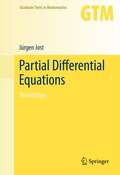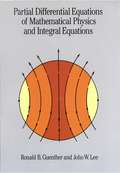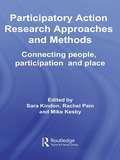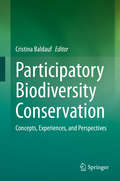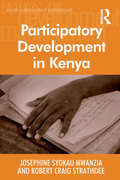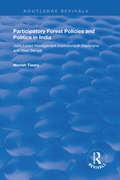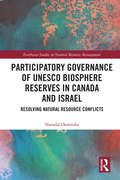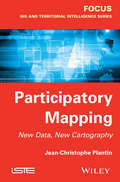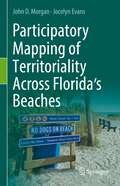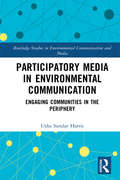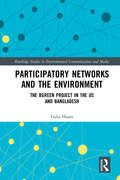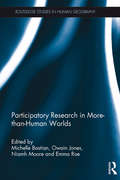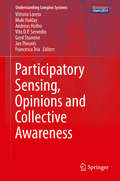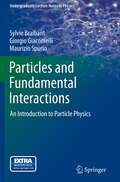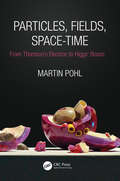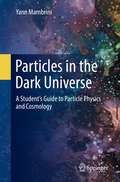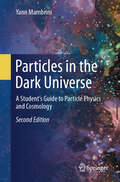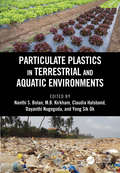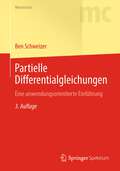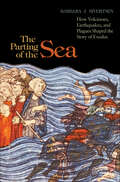- Table View
- List View
Partial Differential Equations
by Jürgen JostThis book offers an ideal graduate-level introduction to the theory of partial differential equations. The first part of the book describes the basic mathematical problems and structures associated with elliptic, parabolic, and hyperbolic partial differential equations, and explores the connections between these fundamental types. Aspects of Brownian motion or pattern formation processes are also presented. The second part focuses on existence schemes and develops estimates for solutions of elliptic equations, such as Sobolev space theory, weak and strong solutions, Schauder estimates, and Moser iteration. In particular, the reader will learn the basic techniques underlying current research in elliptic partial differential equations. This revised and expanded third edition is enhanced with many additional examples that will help motivate the reader. New features include a reorganized and extended chapter on hyperbolic equations, as well as a new chapter on the relations between different types of partial differential equations, including first-order hyperbolic systems, Langevin and Fokker-Planck equations, viscosity solutions for elliptic PDEs, and much more. Also, the new edition contains additional material on systems of elliptic partial differential equations, and it explains in more detail how the Harnack inequality can be used for the regularity of solutions.
Partial Differential Equations for Mathematical Physicists
by Bijan Kumar BagchiPartial Differential Equations for Mathematical Physicists is intended for graduate students, researchers of theoretical physics and applied mathematics, and professionals who want to take a course in partial differential equations. This book offers the essentials of the subject with the prerequisite being only an elementary knowledge of introductory calculus, ordinary differential equations, and certain aspects of classical mechanics. We have stressed more the methodologies of partial differential equations and how they can be implemented as tools for extracting their solutions rather than dwelling on the foundational aspects. After covering some basic material, the book proceeds to focus mostly on the three main types of second order linear equations, namely those belonging to the elliptic, hyperbolic, and parabolic classes. For such equations a detailed treatment is given of the derivation of Green's functions, and of the roles of characteristics and techniques required in handling the solutions with the expected amount of rigor. In this regard we have discussed at length the method of separation variables, application of Green's function technique, and employment of Fourier and Laplace's transforms. Also collected in the appendices are some useful results from the Dirac delta function, Fourier transform, and Laplace transform meant to be used as supplementary materials to the text. A good number of problems is worked out and an equally large number of exercises has been appended at the end of each chapter keeping in mind the needs of the students. It is expected that this book will provide a systematic and unitary coverage of the basics of partial differential equations. Key Features An adequate and substantive exposition of the subject. Covers a wide range of important topics. Maintains mathematical rigor throughout. Organizes materials in a self-contained way with each chapter ending with a summary. Contains a large number of worked out problems.
Partial Differential Equations of Mathematical Physics and Integral Equations
by Ronald B. Guenther John W. LeeThis book was written to help mathematics students and those in the physical sciences learn modern mathematical techniques for setting up and analyzing problems. The mathematics used is rigorous, but not overwhelming, while the authors carefully model physical situations, emphasizing feedback among a beginning model, physical experiments, mathematical predictions, and the subsequent refinement and reevaluation of the physical model itself. Chapter 1 begins with a discussion of various physical problems and equations that play a central role in applications. The following chapters take up the theory of partial differential equations, including detailed discussions of uniqueness, existence, and continuous dependence questions, as well as techniques for constructing conclusions. Specifically, Chapters 2 through 6 deal with problems in one spatial dimension. Chapter 7 is a detailed introduction to the theory of integral equations; then Chapters 8 through 12 treat problems in more spatial variables. Each chapter begins with a discussion of problems that can be treated by elementary means, such as separation of variables or integral transforms, and which lead to explicit, analytical representations of solutions. The minimal mathematical prerequisites for a good grasp of the material in this book are a course in advanced calculus, or an advanced course in science or engineering, and a basic exposure to matrix methods. Students of mathematics, physics, engineering, and other disciplines will find here an excellent guide to mathematical problem-solving techniques with a broad range of applications. For this edition the authors have provided a new section of Solutions and Hints to selected Problems. Suggestions for further reading complete the text.
Participatory Action Research Approaches and Methods: Connecting People, Participation and Place (Routledge Studies in Human Geography)
by Sara Kindon Rachel Pain Mike KesbyParticipatory Action Research (PAR) approaches and methods have seen an explosion of recent interest in the social and environmental sciences. PAR involves collaborative research, education and action which is oriented towards social change, representing a major epistemological challenge to mainstream research traditions. It has recently been the subject of heated critique and debate and rapid theoretical and methodological development. This book captures these developments, exploring the justification, theorisation, practice and implications of PAR. It offers a critical introduction to understanding and working with PAR in different social, spatial and institutional contexts. The authors engage with PAR’s radical potential, while maintaining a critical awareness of its challenges and dangers. The book is divided into three parts. The first part explores the intellectual, ethical and pragmatic contexts of PAR; the development and diversity of approaches to PAR; recent poststructuralist perspectives on PAR as a form of power; the ethic of participation; and issues of safety and well-being. Part two is a critical exploration of the politics, places and practices of PAR. Contributors draw on diverse research experiences with differently situated groups and issues including environmentally sustainable practices, family livelihoods, sexual health, gendered experiences of employment, and specific communities such as people with disabilities, migrant groups, and young people. The principles, dilemmas and strategies associated with participatory approaches and methods including diagramming, cartographies, art, theatre, photovoice, video and geographical information systems are also discussed. Part three reflects on how effective PAR is, including the analysis of its products and processes, participatory learning, representation and dissemination, institutional benefits and challenges, and working between research, action, activism and change. The authors find that a spatial perspective and an attention to scale offer helpful means of negotiating the potentials and paradoxes of PAR. This approach responds to critiques of PAR by highlighting how the spatial politics of practising participation can be mobilised to create more effective and just research processes and outcomes. The book adds significant weight to the recent critical reappraisal of PAR, suggesting why, when, where and how we might take forward PAR’s commitment to enabling collaborative social transformation. It will be particularly useful to researchers and students of Human Geography, Development Studies and Sociology.
Participatory Biodiversity Conservation: Concepts, Experiences, and Perspectives
by Cristina BaldaufIt has long been claimed that addressing biodiversity loss and other environmental problems demands a better understanding of the social dimensions of conservation; nevertheless, the active participation of indigenous peoples and local communities (IPLCs) in conservation initiatives is still a challenging and somehow controversial issue. In this context, this book hopes to give voice to other perspectives related to biodiversity conservation beyond the “fortress conservation” model and emphasize one of the pillars of democracy – popular participation. It covers a wide range of environments and issues of special significance to the topic, such as the expansion of culturally constructed niches, protected areas and food security, community-based management, participatory agroforestry, productive restoration and biocultural conservation. The contents also explore the limitations and shortcomings of participatory practices in protected areas, the relationship between the global crisis of democracy and the decline of biocultural diversity, as well as present current discussions on policy frameworks and governance systems for effective participatory biodiversity conservation. In sum, this book provides a comprehensive and realistic perspective on the social dimensions of conservation based on a series of interrelated themes in participatory biodiversity conservation. The connections between biocultural conservation and the current political and economic environment are highlighted through the chapters and the book closes with a debate on ways to reconcile human welfare, environmental justice and biodiversity conservation.
Participatory Design and Social Transformation: Images and Narratives of Crisis and Change (Routledge Focus on Environment and Sustainability)
by John A. BruceParticipatory Design and Social Transformation introduces theories and methodologies for using image-oriented narratives as modes of inquiry and proposition toward greater justice and equity for society and the environment. Participatory artistic- and design-based research encounters – being, making, and learning with people, things, and situations – are explored through practices that utilize image-oriented and cinematic narratives. Collaborative alliances are invited to consider aesthetics, visuality, attunement, reflection, reciprocity, and care as a means for transdisciplinary approaches that foster generative and ethically responsible conditions toward collective liberation. The design of spectacles is proposed as a way for collective movements to affectively contribute to positive systemic changes from the ground up. In this way, Participatory Design and Social Transformation bridges contemporary advances in design theory and practice with media and art theory, the human and social sciences, and a pedagogy of interdependence. Participatory Design and Social Transformation will be of great interest to both professional and academic communities, providing resources for researchers, artists, designers, activists, students, educators, and leaders engaged with initiatives for transformation.
Participatory Development in Kenya: Empowerment Transformation And Sustainability (Voices In Development Management Ser.)
by Josephine Syokau Mwanzia Robert Craig StrathdeeParticipatory Development (PDev) has been embraced by Third World governments and international organizations such as the World Bank as a means to reduce poverty and empower disadvantaged communities. The emphasis on creating partnerships and using participatory and people-centred approaches has obvious political appeal, yet there is evidence that in practice interventions designed to increase PDev and reduce poverty have yet to have the desired empowerment, transformation and sustainability effect. Using an in-depth study of the Basic Education Improvement Project (BEIP) implemented by the Government of Kenya, the authors of this book critically assess the fit between policy, practice and theory of PDev to shed light on theoretical debates that are on-going in development.
Participatory Forest Policies and Politics in India: Joint Forest Management Institutions in Jharkhand and West Bengal (Routledge Revivals)
by Manish TiwaryOriginally published in 2004. In a radical breakaway from colonial and postcolonial policies that were based on centralized and revenue-orientated control of forests, the government of India announced the Joint Forest Management (JFM) policy resolution in 1990. JFM promised important managerial concessions, including share in cash profit from the timber harvest to forest citizens, in exchange for management of state-owned forests. The government also asked the Forest Departments to invite village councils and NGOs to take part in the joint forest management schemes. Over a decade since its inception this volume examines the JFM, highlighting how state bureaucracy, local institutions and NGOs attempt to achieve the multiple goals of meeting subsistence needs, rural equity, sustainable forestry practices, and forest cover conservation. Investigating four institutions - village-based forest protection groups, the Forest Department, village councils, and NGOs - across the States of Jharkhand and West Bengal, the book focuses on forest citizens and how they interact with other JFM institutions. In doing so, it challenges notions of assumed virtues of moral economy and romanticized views of gender and indigenous knowledge and practices. The monograph also raises issues of social capital (local history, politics and leadership), common property resource (CPR) management and incentives for participation. While pointing out various inconsistencies that exist in the participatory forest framework, the book also shows the potential of JFM and suggests future directions forest management should take in India and elsewhere.
Participatory Governance of UNESCO Biosphere Reserves in Canada and Israel: Resolving Natural Resource Conflicts (Earthscan Studies in Natural Resource Management)
by Natasha DonevskaThis book explores how participatory governance processes help to find integrated solutions to resource-based development while protecting ecosystems in UNESCO designated areas. Participatory Governance of UNESCO Biosphere Reserves in Canada and Israel explores how stakeholders’ participation in decision-making processes related to natural resource management facilitates or hinders the obtainment of an acceptable balance between nature protection and sustainable development policies in the eyes of the participating stakeholders. A comparative analysis of nature versus development conflicts in the Megiddo and Mount Carmel biosphere reserves in Israel and the Mount Arrowsmith and Clayoquot Sound biosphere reserves in Canada, showcases the different approaches in implementing the biosphere reserve concept. The participatory processes of stakeholders, including governments, resource-based industries, local and indigenous communities and environmental NGOs established to address the local natural resource use problems are considered to be an opportunity of reconciliation among stakeholders with diverse interests, lifestyles and cultures but also improving the relationship between man and nature. Yet, achievement of these goals has proven to be a challenge. In some cases the participatory decision-making process yields benefits and in some cases it fails to deliver expected results. This book explores why is that the case. This title will be of great interest to students and scholars of natural resource management, integrated approaches to conservation and sustainable development, and participatory governance of social-ecological systems. It will also be of interest to environmental conflict mediators, participatory process facilitators, policymakers and professionals involved in managing social-ecological systems or establishing biosphere reserves.
Participatory Mapping: New Data, New Cartography
by Jean-Christophe PlantinThis book is intended for applications of online digital mapping, called mashups (or composite application), and to analyze the mapping practices in online socio-technical controversies. The hypothesis put forward is that the ability to create an online map accompanies the formation of online audience and provides support for a position in a debate on the Web.The first part provides a study of the map: - a combination of map and statistical reason- crosses between map theories and CIS theories- recent developments in scanning the map, from Geographic Information Systems (GIS) to Web map.The second part is based on a corpus of twenty "mashup" maps, and offers a techno-semiotic analysis highlighting the "thickness of the mediation" they are in a process of communication on the Web. Map as a device to "make do" is thus replaced through these stages of creation, ranging from digital data in their viewing, before describing the construction of the map as a tool for visual evidence in public debates, and ending with an analysis of the delegation action against Internet users.The third section provides an analysis of these mapping practices in the case study of the controversy over nuclear radiation following the accident at the Fukushima plant on March 11, 2011. Techno-semiotic method applied to this corpus of radiation map is supplemented by an analysis of web graphs, derived from "digital methods" and graph theory, accompanying the analysis of the previous steps maps (creating Geiger data or retrieving files online), but also their movement, once maps are made.
Participatory Mapping of Territoriality Across Florida’s Beaches
by John D. Morgan Jocelyn EvansThis book offers a theoretical and practical exploration of the beach as space and places unique disciplinary lenses (Political Science and Geography). If we accept that what one possesses, one has a claim to, becoming property, then how that possession is enforced, socially, makes all the difference in defining what constitutes territoriality. Morgan and his colleagues have carried out various studies and applied various methods to study the developing coast of Florida. From these efforts, we compare the different regions of the State (e.g., Florida panhandle vs. South Florida) in terms of local beach culture and economics to unpack the topic of tension between beach property and access using firsthand accounts in many cases. This book approaches the complex topic of territoriality on Florida’s beaches from multiple perspectives but related methods involving time geography, a public space index, participatory mapping/cartography, and transboundary viewsheds. This analysis illustrates the fruitfulness of conceptualizations of property that are complex, multiplicative, and evolving. It calls for a recognition of human rights to the commons -- both now and in the future. And it highlights the constructed nature of public space - as a space that provides meaning through bodily performance and encounter. Approaches the complex topic of territoriality on Florida’s beaches from methods of participatory mapping/cartography and performance art.Offers a theoretical and practical exploration of the beach as space and place.Utilizes the lens of territoriality and field-based participant cartographic mapping to understand better how the developed shoreline is territorialized.
Participatory Media in Environmental Communication: Engaging Communities in the Periphery (Routledge Studies in Environmental Communication and Media)
by Usha Sundar HarrisParticipatory Media in Environmental Communication brings together stories of communities in the Pacific islands – a region that is severely affected by the impacts of climate change. Despite living on the margins of the digital revolution, these island communities have used media and communication to create awareness of and find solutions to environmental challenges. By telling their stories in their own way, ordinary people are able to communicate compelling accounts of how different, but interrelated, environmental, political, and economic issues converge and impact at a local level. This book fills a significant gap in our understanding of how participatory media is used as a dialogic tool to raise awareness and facilitate discussion of environmental issues that are now critical. It includes a section on pedagogy and practice – the undergirding principles, the tools, the methods. The book offers a framework for Participatory Environmental Communication that weaves three widely used concepts, diversity, network and agency, into a cohesive underlying system to bring scholars, practitioners and diverse communities together in a dialogue about pressing environmental issues. This book is a valuable resource for researchers and students in communication and media studies, environmental communication, cultural studies, and environmental sciences, as well as practitioners, policy makers and environmental activists.
Participatory Networks and the Environment: The BGreen Project in the US and Bangladesh (Routledge Studies in Environmental Communication and Media)
by Fadia HasanSeeking innovative answers to global sustainability challenges has become an urgent need with the onslaught of environmental and ecological degradation that surrounds us today. More than ever, there is a need to carve new ways for citizens and different industries and institutions to unite – to cooperate, communicate and collaborate to address growing global sustainability concerns. This book examines one such global collaboration called The BGreen Project (BGreen): a transnational participatory action research project that spans the United States and Bangladesh with the aim of addressing environmental issues via academic–community engagement. By analysing and unpacking the architecture of BGreen, Hasan teases out the key factors that are required for the continued momentum of environmentally focused, academic–community partnership projects in order to present a workable model that could be applied elsewhere. This model is based around a unique conceptual framework developed by the author – “transnational participatory networks” – which is drawn from participatory action research and actor network theory, with the specific aim of addressing the common challenge of building evolving, stable and sustainable networks. This book will be of great interest to students and scholars of environmental communication, citizen participation, environmental politics, environmental sociology and sustainable development.
Participatory Research and Planning in Practice (The Urban Book Series)
by Janez Nared David BoleThis open access book provides in-depth insights into participatory research and planning by presenting practical examples of its use. In particular, it describes theoretical and methodological aspects of participatory research and planning, as well as the implementation of participatory processes in fields such as transport planning, cultural heritage management, environmental planning and post-earthquake recovery. Further, it compares participatory planning experiences from different territorial levels – from the macro-regional, e.g. Southeastern Europe, Mediterranean or European metropolitan regions, to national, regional and local levels.The book will help researchers, planners, public administration officials, decision-makers and the general public to understand the advantages, disadvantages and constraints of participatory planning and research. Using various examples, it will guide readers through the theory of participatory planning and research, its methods, and different perspectives on how to use it in practice.
Participatory Research in More-than-Human Worlds (Routledge Studies in Human Geography)
by Michelle Bastian Owain Jones Niamh Moore Emma RoeSocio-environmental crises are currently transforming the conditions for life on this planet, from climate change, to resource depletion, biodiversity loss and long-term pollutants. The vast scale of these changes, affecting land, sea and air have prompted calls for the ‘ecologicalisation’ of knowledge. This book adopts a much needed ‘more-than-human’ framework to grasp these complexities and challenges. It contains multidisciplinary insights and diverse methodological approaches to question how to revise, reshape and invent methods in order to work with non-humans in participatory ways. The book offers a framework for thinking critically about the promises and potentialities of participation from within a more-than-human paradigm, and opens up trajectories for its future development. It will be of interest to those working in the environmental humanities, animal studies, science and technology studies, ecology, and anthropology.
Participatory Sensing, Opinions and Collective Awareness
by Francesca Tria Jan Theunis Gerd Stumme Vito D. P. Servedio Andreas Hotho Muki Haklay Vittorio LoretoThis book introduces and reviews recent advances inthe field in a comprehensive and non-technical way by focusing on the potentialof emerging citizen-science and social-computation frameworks, coupled with thelatest theoretical and modeling tools developed by physicists, mathematicians,computer and social scientists to analyse, interpret and visualize complex datasets. There is overwhelming evidence that the currentorganisation of our economies and societies is seriously damaging biologicalecosystems and human living conditions in the short term, with potentiallycatastrophic effects in the long term. The need to re-organise the dailyactivities with the greatest impact - energy consumption, transport, housing -towards a more efficient and sustainable development model has recently beenraised in the public debate on several global, environmental issues. Above all,this requires the mismatch between global, societal and individual needs to beaddressed. Recent advances in Information and Communication Technologies (ICT)can trigger important transitions at the individual and collective level toachieve this aim. Based on the findings of the collaborative researchnetwork EveryAware the following developments among the emerging ICTtechnologies are discussed in depth in this volume: * Participatory sensing - where ICT development ispushed to the level where it can supportinformed action at the hyperlocal scale, providing capabilities forenvironmental monitoring, data aggregation and mining, as well as informationpresentation and sharing. * Web gaming, social computing and internet-mediatedcollaboration - where the Web will continue to acquire the status of aninfrastructure for social computing, allowing users' cognitive abilities to becoordinated in online communities, and steering the collective action towardspredefined goals. * Collective awareness and decision-making - where theaccess to both personal and community data, collected by users, processed withsuitable analysis tools, and re-presented in an appropriate format by usablecommunication interfaces leads to a bottom-up development of collective socialstrategies.
Particles and Fundamental Interactions: Supplements, Problems and Solutions
by Sylvie Braibant Maurizio Spurio Giorgio GiacomelliThis volume is an exercises and solutions manual that complements the book "Particles and Fundamental Interactions" by Sylvie Braibant, Giorgio Giacomelli, and Maurizio Spurio. It aims to give additional intellectual stimulation for students in experimental particle physics. It will be a helpful companion in the preparation of a written examination, but also it provides a means to gaining a deeper understanding of high energy physics. The problems proposed are sometimes true and important research questions, which are described and solved in a step-by-step manner. In addition to the problems and solutions, this book offers fifteen Supplements that give further insight into topical subjects related to particle accelerators, signal and data acquisition systems and computational methods to treat them.
Particles and Fundamental Interactions
by Giorgio Giacomelli Maurizio Spurio Sylvie BraibantThe book provides theoretical and phenomenological insights on the structure of matter, presenting concepts and features of elementary particle physics and fundamental aspects of nuclear physics. Starting with the basics (nomenclature, classification, acceleration techniques, detection of elementary particles), the properties of fundamental interactions (electromagnetic, weak and strong) are introduced with a mathematical formalism suited to undergraduate students. Some experimental results (the discovery of neutral currents and of the W± and Z0 bosons; the quark structure observed using deep inelastic scattering experiments) show the necessity of an evolution of the formalism. This motivates a more detailed description of the weak and strong interactions, of the Standard Model of the microcosm with its experimental tests, and of the Higgs mechanism. The open problems in the Standard Model of the microcosm and macrocosm are presented at the end of the book. For example, the CP violation currently measured does not explain the matter-antimatter asymmetry of the observable universe; the neutrino oscillations and the estimated amount of cosmological dark matter seem to require new physics beyond the Standard Model. A list of other introductory texts, work reviews and some specialized publications is reported in the bibliography. Translation from the Italian Language Edition "Particelle e interazioni fondamentali" by Sylvie Braibant, Giorgio Giacomelli, and Maurizio Spurio Copyright © Springer-Verlag Italia, 2009 Springer-Verlag Italia is part of Springer Science+Business Media All Rights Reserved
Particles, Fields, Space-Time: From Thomson’s Electron to Higgs’ Boson
by Martin PohlCHOICE Highly Recommended 2021Particles, Fields, Space-Time: From Thomson's Electron to Higgs' Boson explores the concepts, ideas, and experimental results that brought us from the discovery of the first elementary particle in the end of the 19th century to the completion of the Standard Model of particle physics in the early 21st century. The book concentrates on disruptive events and unexpected results that fundamentally changed our view of particles and how they move through space-time. It separates the mathematical and technical details from the narrative into focus boxes, so that it remains accessible to non-scientists, yet interesting for those with a scientific background who wish to further their understanding. The text presents and explains experiments and their results wherever appropriate.This book will be of interest to a general audience, but also to students studying particle physics, physics teachers at all levels, and scientists with a recreational curiosity towards the subject.Features Short, comprehensive overview concentrating on major breakthroughs, disruptive ideas, and unexpected results Accessible to all interested in subatomic physics with little prior knowledge required Contains the latest developments in this exciting field
Particles in the Coastal Ocean Theory and Applications
by Daniel R. Lynch David A. Greenberg Ata Bilgili Dennis J. Mcgillicuddy Jr. James P. Manning Alfredo L. AretxabaletaThe coastal ocean comprises the semi-enclosed seas on the continental shelf, including estuaries and extending to the shelf break. This region is the focus of many serious concerns, including coastal inundation by tides, storm surges, or sea level change; fisheries and aquaculture management; water quality; harmful algal blooms; planning of facilities (e. g. , power stations); port development and maintenance; and oil spills. This book addresses modeling and simulation of the transport, evolution, and fate of particles (physical and biological) in the coastal ocean. It is the first to summarize the state of the art in this field and direct it toward diverse applications, for example in measuring and monitoring sediment motion, oil spills, and larval ecology. This is an invaluable textbook and reference work for advanced students and researchers in oceanography, geophysical fluid dynamics, marine and civil engineering, computational science, and environmental science.
Particles in the Dark Universe: A Student’s Guide to Particle Physics and Cosmology
by Yann MambriniThis book provides a comprehensive and instructive coverage of particle physics in the early universe, in a logical way. It starts from the thermal history of the universe by investigating some of the main arguments such as Big Bang nucleosynthesis, the cosmic microwave background (CMB) and the inflation, before treating in details the direct and indirect detection of dark matter and then some aspects of the physics of neutrino. Following, it describes possible candidates for dark matter and its interactions.The book is targeted at theoretical physicists who deal with particle physics in the universe, dark matter detection and astrophysical constraints, and at particle physicists who are interested in models of inflation or reheating. This book offers also material for astrophysicists who work with quantum field theory computations. All that is useful to compute any physical process is included: mathematical tables, all the needed functions for the thermodynamics of early universe and Feynman rules. In light of this, this book acts as a crossroad between astrophysics, particle physics and cosmology.
Particles in the Dark Universe: A Student’s Guide to Particle Physics and Cosmology
by Yann MambriniThis second edition of Particles in the Dark Universe has been substantially enhanced with several new chapters that delve into crucial aspects of particle physics in the Universe. These additions encompass the role of primordial black holes in the early universe, tracing their formation to decay, unification theories, a comprehensive historical overview of cosmological models, an extensive examination of the physics of the graviton, and an educational exploration of gravitational phenomena such as Unruh-type or Hawking radiation. Additionally, this edition incorporates 30 new exercises and provides a comprehensive presentation of inflationary models, along with a pedagogical insight into the mechanism of baryogenesis. Structured in a logical sequence, this book offers a thorough and instructional exploration of particle physics within the early universe. It initiates by elucidating the thermal history of the universe, delving into pivotal concepts like Big Bang nucleosynthesis, the cosmic microwave background (CMB), and inflation. Subsequently, it meticulously addresses both direct and indirect detection methods of dark matter, followed by an in-depth analysis of neutrino physics. The book further scrutinizes potential candidates for dark matter and their interactions. Designed for theoretical physicists engaged in particle physics within the universe, dark matter detection, astrophysical constraints, and those interested in models of inflation or reheating, this book also caters to astrophysicists involved in quantum field theory computations. It encompasses all essential elements required for computing various physical processes, providing mathematical tables, necessary thermodynamic functions for the early universe, and Feynman rules. Consequently, this book serves as an intersecting point between astrophysics, particle physics, and cosmology.
Particulate Plastics in Terrestrial and Aquatic Environments
by Nanthi S. Bolan, M.B. Kirkham, Claudia Halsband, Dayanthi Nugegoda, Yong Sik OkThe manufacture of plastic as well as its indiscriminate disposal and destruction by incineration pollutes atmospheric, terrestrial, and aquatic ecosystems. Synthetic plastics do not break down; they accumulate in the environment as macro-, micro-, and nanoplastics. These particulate plastics are a major source of pollutants in soil and marine ecosystems. Particulate Plastics in Terrestrial and Aquatic Environments provides a fundamental understanding of the sources of these plastics and the threats they pose to the environment. The book demonstrates the ecotoxicity of particulate plastics using case studies and offers management practices to mitigate particulate plastic contamination in the environment. Features · Describes physical and chemical properties of particulate plastics in terrestrial and aquatic ecosystems · Presents information on characteristics of particulate plastics as impacted by weathering processes · Provides numerous approaches for managing particulate plastic contamination · Identifies sources of particulate plastics in the environment; distribution and characteristics of particulate plastics; and management strategies of particulate plastics Written by a global team of scientists, this book is for researchers in the fields of environmental safety and waste management or individuals interested in the impact of particulate plastics on environmental health.
Partielle Differentialgleichungen: Eine anwendungsorientierte Einführung (Masterclass)
by Ben SchweizerDas Buch führt in die Theorie der Partiellen Differentialgleichungen ein, lediglich die Grundvorlesungen der Analysis werden vorausgesetzt. Eine Vielzahl linearer und nichtlinearer Differentialgleichungen wird mit Modellierungsansätzen motiviert und rigoros analysiert. Nach den klassischen linearen Problemen der Potentialtheorie und Wärmeleitung werden insbesondere nichtlineare Probleme aus der Theorie poröser Medien, der Strömungsmechanik und der Festkörpermechanik behandelt. Entlang der Aufgabenstellungen von zunehmender Komplexität werden moderne Methoden und Theorien der Analysis entwickelt.Für die vorliegende 3. Auflage wurde der Text überarbeitet und korrigiert, an vielen Stellen wurden Beweisabläufe optimiert und Motivationstexte eingebaut. An anderen Stellen inhaltlich ausgedünnt und verkürzt, um den Vorlesungsumfang nicht zu sprengen.
The Parting of the Sea: How Volcanoes, Earthquakes, and Plagues Shaped the Story of Exodus
by Barbara J. SivertsenFor more than four decades, biblical experts have tried to place the story of Exodus into historical context--without success. What could explain the Nile turning to blood, insects swarming the land, and the sky falling to darkness? Integrating biblical accounts with substantive archaeological evidence, The Parting of the Sea looks at how natural phenomena shaped the stories of Exodus, the Sojourn in the Wilderness, and the Israelite conquest of Canaan. Barbara Sivertsen demonstrates that the Exodus was in fact two separate exoduses both triggered by volcanic eruptions--and provides scientific explanations for the ten plagues and the parting of the Red Sea. Over time, Israelite oral tradition combined these events into the Exodus narrative known today. Skillfully unifying textual and archaeological records with details of ancient geological events, Sivertsen shows how the first exodus followed a 1628 B.C.E Minoan eruption that produced all but one of the first nine plagues. The second exodus followed an eruption of a volcano off the Aegean island of Yali almost two centuries later, creating the tenth plague of darkness and a series of tsunamis that "parted the sea" and drowned the pursuing Egyptian army. Sivertsen's brilliant account explains inconsistencies in the biblical story, fits chronologically with the conquest of Jericho, and confirms that the Israelites were in Canaan before the end of the sixteenth century B.C.E. In examining oral traditions and how these practices absorb and process geological details through storytelling, The Parting of the Sea reveals how powerful historical narratives are transformed into myth.
